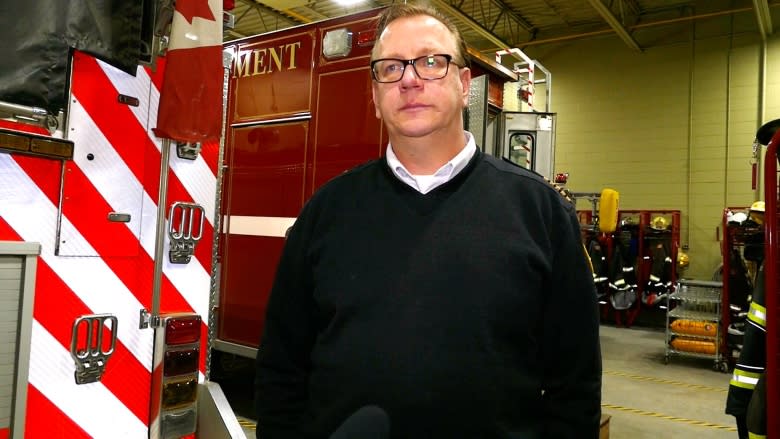Manitoba communities struggle to find volunteer firefighters
The latest census data, released last month, showed a number of communities in Manitoba gained residents. Others lost residents. But some communities on both sides of the spectrum share one issue: the challenge of populating volunteer fire departments.
"It's getting tougher and tougher to get volunteers," said Rob Brown, deputy chief of the fire department in Waskada, Man., a village of about 170 people located 280 kilometres southwest of Winnipeg in the heart of Manitoba's oil patch.
Brown said the department currently has between 10 and 15 active volunteers and while they're dedicated, he said it's sometimes hard to get a large enough crew together to attend calls.
Ideally, Brown said, the department would have between 15 and 20 volunteers.
If he couldn't get a crew together, Waskada would have to turn to nearby communities like Melita or Deloraine for help, potentially adding precious minutes to a response time.
That's something his community hasn't had to do yet, Brown said.
Fire officials in some towns closer to the city of Brandon, like Minnedosa and Rivers, Man., said they have adequate staffing. But in Waskada, it's a concern.
"With everybody working further away out of the area ... both family members are pretty much contributing to the take-home pay so it's tougher to find volunteers," Brown said.
Compounding the issue is the fact that the volunteer base is shrinking.
Waskada's population shrunk about nine per cent between 2011 and 2016, according to the latest census data.
"The biggest problem that we hear from rural fire departments ... is the issue of recruitment and retention," said Cam Abrey, president of the Manitoba Association of Fire Chiefs.
"How do we find new members across our shirking communities, our dwindling communities? And the members that we do have, how do we keep them in the department?"
Not just a small-town problem
It's not just small or shrinking communities feeling the pinch either. Abrey, who is also the chief of the Dauphin Fire Department, said he struggles to maintain a full roster of 36 firefighters in the city of about 8,400 people, located 250 kilometres northwest of Winnipeg.
Right now, the department has 31 firefighters. It's a paid-call fire department, which means firefighters receive payment only when they attend regularly scheduled training or respond to alarms. But community members have to volunteer to become part of the department.
"Unfortunately, this is another one of those volunteer groups but they provide some very important services ... required services to the communities in which they live," said Abrey.
Dauphin's population grew by about three per cent in the past five years. Abrey said the department sees a turnover of between six and 12 members per year.
"Life changes for them, children are born, jobs, career changes, they move out of the community, whatever happens," he said.
"It seems like it's harder to get volunteers for stuff in the rural areas more and more, and of course the depopulation doesn't help out either," said Brown, adding that the lack of volunteers goes well beyond the fire department.
"Years ago, I think more people had time for stuff like this."
Problem across Canada
Abrey said departments in many provinces across Canada are having the same issues as some departments in Manitoba.
In Alberta, he said the provincial association launched an initiative called "Answer the Call," a recruitment video and information campaign meant to give people a sense of what being a firefighter is like.
"It was talking about who can be a firefighter," he said. "A school teacher can be a firefighter as well … a construction worker, somebody that runs a grocery store, works in a grocery store, anybody to come out and help their communities like that."
Abrey, an 18-year member of the fire department, said requirements for volunteers in Dauphin have been relaxed. Before, firefighters had to live within city limits. Now, they have to live within seven miles, or approximately 11 kilometres, from the fire station — a change that opened the door to those living just outside of the city.
Abrey said the city force has tried recruitment drives in the past with varying success. Word of mouth, he said, has been the best form of recruitment. But some would-be firefighters find the job isn't for them.
"They'd find in two to three months down the road that it maybe wasn't what they were expecting it was or the training requirements were too much for them," Abrey said, adding that recruitment drives would typically net between six and 10 new members.
Abrey said new recruits have to take around 120 hours of training to attain Level 1 firefighter accreditation, the most basic level. That's something that has deterred some potential firefighters.
Ask a firefighter
He encourages anyone who might want to join their local fire department to first ask either the chief or other firefighters about what the job entails.
"Especially in the small communities, you're responding to your friends, your neighbours, your family when they're calling for help," Abrey said. "That can have a lot of stress on an individual when they join a fire department."
But even so, he still says there's tremendous value to being a volunteer firefighter.
"It is probably the most rewarding way to help out your community, because you are responding to someone's worst day of their life and you are there to help them," he said.




